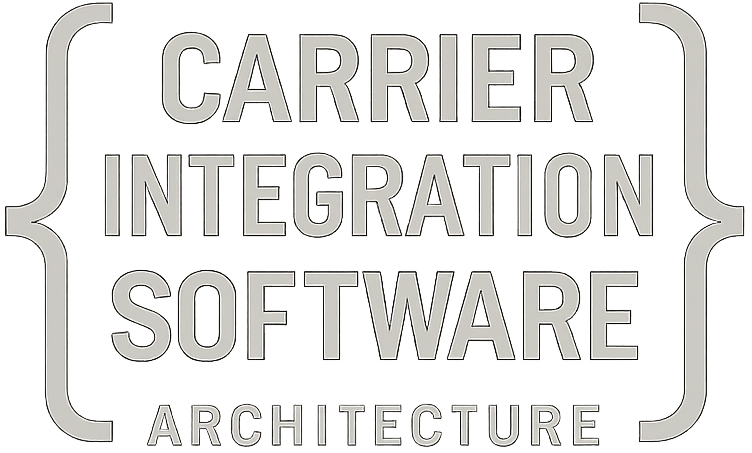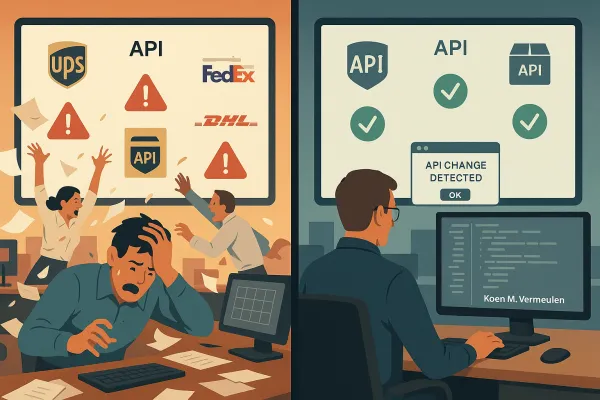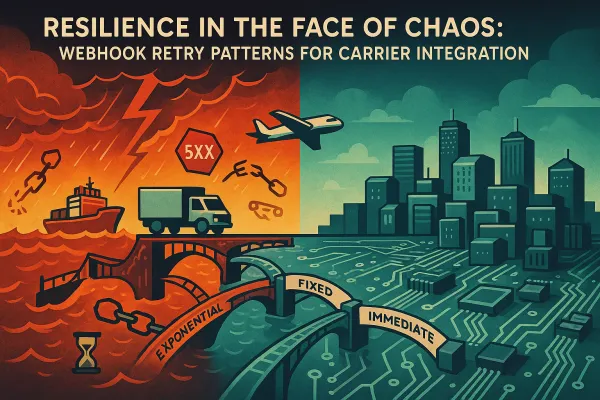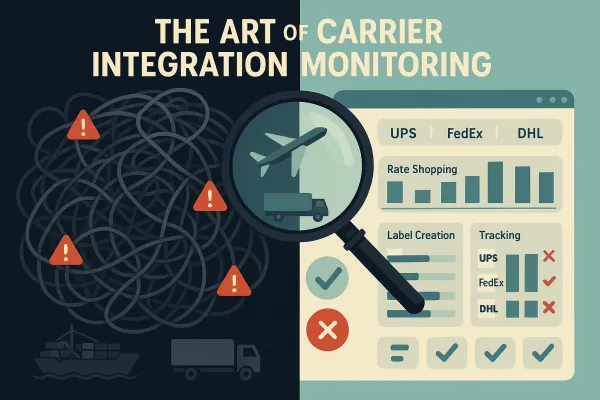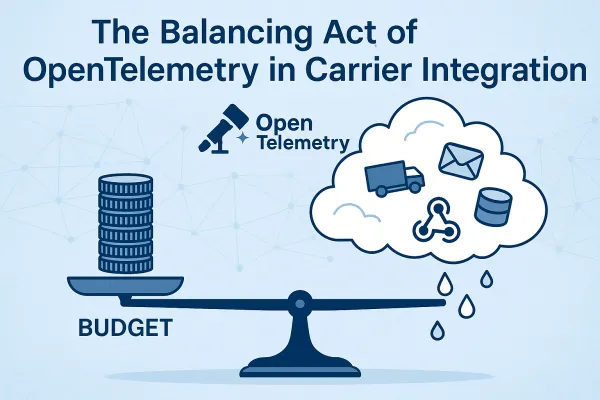Webhook Delivery at Scale: Solving Ordering Challenges in Carrier Integration Systems

Every shipping systems architect has faced this conundrum: your carrier integration platform needs real-time webhook delivery, but your stakeholders insist that tracking updates must arrive "in order". You know intuitively that shipment events follow a natural sequence—label created, picked up, in transit, delivered—so ordering seems obvious. Yet every attempt to guarantee webhook ordering at scale becomes a performance disaster.
If we block the whole queue, then a single failure when sending a minor webhook would completely distrust webhook delivery. We don't really ensure ordering when failures cascade through the system. The reality that most shipping platforms discover is that webhook ordering promises are architectural traps that create more problems than they solve.
Why Guaranteed Ordering Breaks at Scale
The fundamental issue with enforcing webhook ordering in carrier integration systems isn't just complexity—it's the physics of distributed systems working against you. When DHL's tracking API responds in 50ms while FedEx takes 3 seconds for the same request, even if you send first first, it will in practice be processed after second and not before.
Consider a typical label storm scenario during Black Friday. Your platform processes 10,000 shipment labels in an hour, generating webhook events for label creation, carrier acceptance, and initial tracking updates. With strict ordering, one failed delivery to a customer's webhook endpoint blocks thousands of subsequent events across all your tenants. A single failure when sending a minor webhook would completely distrust webhook delivery, and thus the whole service.
Rate limiting compounds this problem. Carrier APIs like UPS and Royal Mail impose different rate limits per integration type. When your webhook delivery system hits these limits while trying to maintain order, you face an impossible choice: drop events or create massive delivery delays that propagate across your entire platform.
The performance degradation becomes measurable quickly. Platforms like Cargoson, nShift, and ShipEngine have all learned that strict webhook ordering reduces overall throughput by 60-80% under realistic load conditions, while increasing failure rates exponentially.
Design Patterns for Order-Independent Webhooks
The solution isn't better queueing—it's designing webhooks that don't need ordering in the first place. You can design your payloads so that your customers have the information they need to process them irregardless of ordering.
Start with event versioning through modification counters. Each webhook payload should include a `version` or `updated_at` timestamp that allows receivers to determine the correct sequence regardless of delivery order:
{
"event_type": "shipment.tracking_updated",
"shipment_id": "ship_12345",
"tracking_number": "1Z999AA1234567890",
"status": "in_transit",
"version": 5,
"updated_at": "2025-01-15T14:30:22Z",
"previous_version": 4
}
Sequence numbering provides another layer of client-side reconstruction. Instead of enforcing server-side ordering, include sequence indicators that webhook consumers can use to handle out-of-order delivery:
{
"event_id": "evt_789",
"sequence_number": 3,
"tenant_id": "customer_abc",
"shipment_sequence": 12
}
For complex carrier integration workflows, implement thin payloads with lookup capabilities. Rather than cramming all state information into each webhook, send minimal event data and provide APIs for retrieving complete state:
{
"event": "shipment.status_changed",
"shipment_id": "ship_12345",
"changed_at": "2025-01-15T14:30:22Z",
"state_url": "/api/v1/shipments/ship_12345/state"
}
This pattern allows your webhook consumers to always retrieve the most current state, regardless of when individual events arrive.
Multi-Tenant Webhook Routing Strategies
Multi-tenant carrier integration platforms face unique challenges when designing webhook delivery systems. In a multi-tenant SaaS application, limit a tenant to 1M events per day. Anything beyond this should be throttled and deferred. But simple global throttling creates cross-tenant interference.
Implement tenant-aware delivery queues using resource isolation. Create separate message queues per tenant class—enterprise customers get dedicated high-priority queues, while standard tenants share capacity-managed queues. This prevents one tenant's webhook delivery issues from impacting others.
Dynamic routing based on carrier SLAs adds another dimension. Royal Mail webhooks might have different reliability requirements than DPD's real-time tracking events. Your routing logic should consider both tenant priority and carrier characteristics:
if (tenant.tier === 'enterprise' && carrier.sla_class === 'premium') {
route_to_priority_queue(webhook_event)
} else if (carrier.requires_ordering) {
route_to_fifo_queue(webhook_event) // Limited use cases only
} else {
route_to_standard_queue(webhook_event)
}
Platforms like Cargoson, MercuryGate, and ShipEngine implement variations of this pattern, typically using separate queue instances rather than queue priorities to ensure true resource isolation. In some scenarios, you might provide different service-level agreements (SLAs) or quality of service (QoS) guarantees to different tenants. By using the Priority Queue pattern, you can create separate queues for different levels of priority.
Reliability Patterns That Actually Work
Effective webhook reliability starts with accepting that failures will happen and designing around them. Use exponential backoff to slowly increase the time between your retries. To avoid laughably large wait periods, set a maximum backoff time (usually once a day) via truncated exponential backoff.
AfterShip's approach provides a practical benchmark: they attempt webhook delivery up to 14 times over 3 days, with delays starting at 15 seconds and maxing out at 8 hours. This balances delivery persistence with resource conservation.
Webhooks typically have "at-least-once" delivery guarantees, which means receiving the same request more than once is possible. You should make your processing idempotent. Implement idempotency keys using a combination of event ID and tenant ID:
const idempotency_key = `${tenant_id}:${event_id}:${webhook_url_hash}`;
if (processed_events.includes(idempotency_key)) {
return { status: 'already_processed', code: 200 };
}
Dead letter queues become essential for handling systematic delivery failures. Rather than infinite retries, route consistently failing webhooks to a dead letter queue after your retry limit. This allows manual investigation without blocking other deliveries.
Webhooks must do three things: respond quickly, handle varying throughput levels, and be able to recover during downtime. Most third party webhooks will consider the request failed if it doesn't respond fast enough. Design your receiving endpoints with HTTP status code of 200 to confirm that you have received it. To not lose any data, you should persist the data immediately, generally using a message queue and process the event asynchronously.
Monitoring and Observability for Webhook Delivery
Without proper observability, webhook delivery issues become invisible until they create business impact. Monitor the percentage of successfully delivered webhooks versus the total number of webhooks sent. This metric provides insight into the reliability of your webhook delivery system.
Define clear SLOs for webhook delivery systems:
- Delivery success rate: >99.5% for critical events (label generation, delivery confirmation)
- Delivery latency: <30 seconds for 95th percentile
- Retry rate: <5% of total events should require retries
- Dead letter rate: <0.1% of events should reach dead letter queues
Measure the time it takes for a webhook to be delivered from the moment it's triggered to the moment it's received by the consumer. You should have ability to slice this data based on tenant-id, destination URL, etc.
Implement event sequence gap detection for scenarios where ordering matters. Create monitors that track sequence numbers per tenant and carrier, alerting when gaps exceed acceptable thresholds:
SELECT tenant_id, MAX(sequence_number) - MIN(sequence_number) - COUNT(*) as gap_count
FROM webhook_events
WHERE created_at > NOW() - INTERVAL '1 hour'
GROUP BY tenant_id
HAVING gap_count > 0;
Dashboard design should focus on actionable metrics. Display delivery success rates by carrier, tenant tier, and event type. Track webhook endpoint health with response time and error rate trends. Most importantly, provide drill-down capabilities from high-level metrics to individual failed deliveries.
Implementation Checklist and Architecture Decisions
When designing your webhook delivery architecture, start with these fundamental decisions:
Technology choices for message processing: Some applications need to process webhooks in the order they were sent. This can complicate scaling, as distributing processing across multiple workers can make maintaining the correct order more challenging. For most shipping use cases, choose Apache Kafka for high-throughput scenarios, AWS SQS for simpler implementations, or Redis Streams for mixed workloads. Avoid RabbitMQ's FIFO queues unless you have genuine ordering requirements for specific event types.
Database design for idempotency: Use composite keys combining tenant_id, event_id, and webhook_url_hash. Set TTL policies on processed event records—typically 30 days for audit purposes, longer for compliance requirements.
Testing strategies for real-world scenarios: Create chaos engineering tests that simulate out-of-order delivery, network partitions, and carrier API failures. Test webhook consumer behaviour when receiving events with sequence gaps or when processing duplicate events hours apart.
Migration from ordered systems: If you're currently enforcing ordering, migrate gradually. Implement version headers first, then introduce parallel unordered processing for non-critical events. Monitor both systems during transition periods, using feature flags to control traffic distribution.
Consider webhook ordering only for these limited scenarios: financial transactions requiring audit trails, multi-step carrier integration workflows where state consistency is legally required, or tenant-specific compliance requirements. In these cases, implement FIFO processing per logical entity (shipment, customer) rather than global ordering.
For webhook delivery infrastructure, evaluate solutions like Svix's FIFO endpoints for the rare cases requiring ordering, while using platforms like Cargoson, EasyPost, or ShipEngine for standard carrier integration webhook patterns that prioritize reliability over strict sequencing.
The path forward is clear: design for reliability and performance first, then add ordering constraints only where business requirements genuinely demand them. Your webhook delivery system will be more resilient, scalable, and maintainable as a result.
